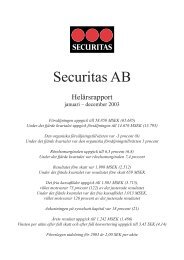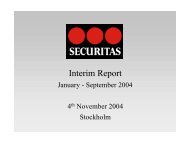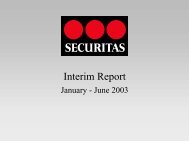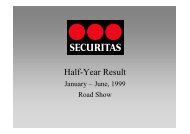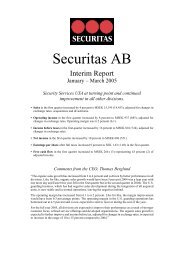Annual Report 2008 - Securitas
Annual Report 2008 - Securitas
Annual Report 2008 - Securitas
You also want an ePaper? Increase the reach of your titles
YUMPU automatically turns print PDFs into web optimized ePapers that Google loves.
Volume-related factors<br />
The first two key figures, New sales (of contracts)<br />
and Net change (of contract portfolio),<br />
relate to the development of the customer<br />
contract portfolio. New sales are new signed<br />
contracts that will increase the monthly fixed<br />
sales. Net change in the customer contract<br />
portfolio is new starts (a new signed contract<br />
that has started) plus increased sales in<br />
existing contracts, less terminated customer<br />
contracts and reduced sales in existing contracts.<br />
Price changes are measured separately and<br />
added to Net change to determine the period’s<br />
closing balance of the contract portfolio. The<br />
closing balance is the total value of monthly<br />
invoicing on our monthly fixed contracts at the<br />
ending date for the current period.<br />
SECURITAS MODEL FOR FINANCIAL KEY FIGURES<br />
Volume-related factors<br />
Efficiency-related factors<br />
Capital-usage-related factors<br />
The table below is an example illustrating the<br />
details of the contract portfolio:<br />
Value<br />
Opening balance 100<br />
+ New starts 15<br />
+ Increases 5<br />
– Terminations –12<br />
– Reductions –4<br />
% change in<br />
opening portfolio<br />
Net change 4 4<br />
Price change 3 3<br />
Closing balance 107 7<br />
The third key figure is taken from the statement<br />
of income and is Total sales, which in addition<br />
to contract-based sales, includes short-term<br />
assignments.<br />
Efficiency related factors<br />
The efficiencyrelated key figures provide managers<br />
with tools to monitor service efficiency<br />
and cost trends. The fourth and fifth key figures<br />
are: Gross margin, which is defined as total<br />
sales less direct expenses as a percentage of<br />
total sales, and Indirect expenses, which pertain<br />
to the organization and include administrative<br />
expenses, (costs of branch, area and regional/<br />
country offices). Gross income less indirect<br />
expenses equals operating income before<br />
amortization of acquisition-related intangible<br />
assets. When this is expressed as a percentage<br />
of total sales, it indicates the Group’s operating<br />
margin, which in <strong>Securitas</strong>’ financial model,<br />
comes before acquisition-related items.<br />
Capital-usage-related factors<br />
<strong>Securitas</strong>’ operations in general are not capitalintensive.<br />
Accounts receivable tie up the most<br />
capital. The sixth key figure is Days of sales<br />
outstanding (DSO). Payment terms and effective<br />
collection procedures are decisive in determining<br />
how much capital is tied up in accounts receivable.<br />
These figures are followed up on an ongoing<br />
basis at all levels in the organization.<br />
GROUP SECURITY SERVICES MOBILE AND MONITORING<br />
New sales New sales/New starts<br />
Gross margin on new sales<br />
Terminations Terminations<br />
Net change Net change<br />
Price change Price change<br />
New/cancelled connections (Monitoring)<br />
Organic sales growth Organic sales growth Organic sales growth<br />
Acquired sales growth<br />
Total sales Total sales Total sales<br />
Employee turnover Employee turnover<br />
Wage cost increase Prospects visited (Mobile)<br />
Cost per sale/order<br />
Average contract size (Mobile)<br />
Pay back time/duration<br />
Gross margin Gross margin<br />
Indirect expenses Indirect expenses<br />
Operating margin Operating margin Operating margin<br />
Income before tax<br />
Earnings per share<br />
Days of sales outstanding Days of sales outstanding<br />
Operating capital employed as % of sales Operating capital employed as % of sales Operating capital employed as % of sales<br />
Cash flow from operating activities as %<br />
of operating income before amortization<br />
Free cash flow<br />
Cash flow from operating activities as %<br />
of operating income before amortization<br />
Cash flow from operating activities as %<br />
of operating income before amortization<br />
Return on capital employed Return on capital employed Return on capital employed<br />
Free cash flow in relation to net debt<br />
<strong>Securitas</strong>’ operations<br />
Management and control of <strong>Securitas</strong><br />
<strong>Securitas</strong> <strong>Annual</strong> <strong>Report</strong> <strong>2008</strong><br />
37




